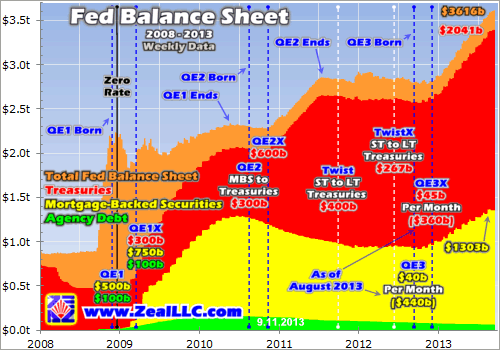Fed Unleashes Gold
Adam Hamilton
The Federal Reserve shocked the financial world this week, defying universal expectations. It failed to start reducing the pace of its third quantitative-easing campaign’s debt monetizations, delaying the long-anticipated QE3 taper indefinitely. This surprise ignited sharp moves in nearly all major markets, but gold’s was certainly the most impressive. It rocketed higher on the Fed’s startling new paradigm shift.
All year long, gold has been plagued by fears of the Fed tapering QE3. Starting with the January 3rd release of the minutes from the December FOMC meeting (where QE3 was more than doubled to include direct Treasury monetizations), QE3-tapering fears have dominated the gold markets. Futures traders in particular have been pathologically obsessed with the QE3 taper, ignoring everything else that affects gold.
Every major gold selloff this year, which has been the worst by far in gold’s secular bull, began with either an FOMC decision or the subsequent release of the minutes from those meetings. Last week I wrote an essaydetailing QE3-tapering fears’ brutal impact on the gold price in 2013. Futures traders hammered it down an astounding 28.3% at worst this year on their belief that the Fed would start tapering QE3 this week.
But after plummeting from about $1675 as 2012 ended to $1200 in late June, the whole premise of that selloffjust vanished Wednesday! After months of setting market expectations for the QE3 taper, Ben Bernanke’s Fed unexpectedly aborted. A perfect opportunity to start tapering, with the stock markets near record highs so they could easily absorb any resulting selling, was spectacularly squandered by the Fed.
Many times this year I’d argued that the Fed couldn’t exit QE3. When it slowed and ultimately stopped buying long-term Treasuries, long interest rates would climb as the dominating buyer exited the market. The resulting higher long rates would collapse the fragile housing recovery and send US unemployment surging higher again. Thanks to Obama’s stupendous debt growth, they’d even sink the US government.
But like nearly everyone else, I bought into the universal expectations that the Fed would start a modest QE3 taper this week. I certainly didn’t believe QE3 would be fully phased out by the middle of next year as most thought, but I couldn’t imagine the Fed taking the huge credibility hit by not tapering. One thing Bernanke’s Fed has been pretty adept at is ensuring its actions meet prevailing market expectations.
The Fed not tapering QE3 this week changes everything. The FOMC holds 8 meetings per year, but only after every other one does the Chairman hold a press conference where he can explain the FOMC’s thinking. There are only 2 meetings left in 2013, October 30th and December 18th. The next one has no press conference, and there is insufficient economic data between now and then to see improvement.
The FOMC chose not to taper QE3 this week because it “decided to await more evidence that progress will be sustained” in “economic activity and labor market conditions”. There’s only one more critical monthly US jobs report before the FOMC’s next meeting, September’s in early October. And after the very weak August jobs report earlier this month, even a great next jobs report isn’t enough data for a trend.
That leaves the December FOMC meeting for a taper, the next one with a Bernanke press conference. But that is really problematic, as is the subsequent January 29th meeting, because of Ben Bernanke’s retirement on January 31st. How to proceed with QE3 is a decision best left to the next Fed Chairman so close to the end of Bernanke’s reign, and she (it will likely be uber-dove Janet Yellen) won’t start until February.
The first FOMC meeting under the new Fed leadership is actually March 19th. So even if US economic data improves dramatically, and even if the levitating stock markets somehow magically manage to avoid correcting sharply, Bernanke’s decision not to taper QE3 likely added at least 6 months to its lifespan! To minimize bond-market carnage, QE3 still has to be tapered gradually no matter when that process starts.
The implications of this are staggering, especially for gold. When the Fed buys bonds, it creates the money to do so out of thin air. Quantitative easing is just a pleasant-sounding euphemism for debt monetization. And when it buys Treasuries in particular, the wildly-overspending Obama Administration immediately injects these new dollars into the economy. The result is QE is pure high-octane inflation.
This first chart is updated from last week, showing the size and composition of the Fed’s balance sheet (the bonds it has purchased). Across it are noted the dates of key FOMC meetings over the past 5 years or so when major policy changes were made. Despite Fed officials endlessly talking about ending QE since 2009, the record shows the Fed has done just the opposite. QE just grew and grew and grew.

The Fed’s balance sheet has grown massively in the QE3 era, up a whopping 29.2% in the year since QE3 was born! That is $818b worth of bonds purchased, a staggering amount of new money created out of thin air in a single year. Indeed as of the end of August, QE3’s $40b per month of mortgage-backed-bond buying and $45b per month of Treasury buying added up to $800b. September is adding another $85b.
QE2 only had $600b of new buying, and that was so inflationary that the gold price surged 24.7% higher over its span. As I outlined last week, Bernanke laid out his best-case (fastest) scenario for QE3 tapering in mid-June. It proposed starting the taper later this year and ending QE3 entirely by mid-2014. If you run the math on this, it would have grown QE3 by another $383b or so, taking its total over a whopping $1250b.
But if this week’s stunning QE3-taper delay indeed costs 6 months due to the big Fed transition and near certainty of the long overdue major stock-market correction, QE3 is going to be vastly bigger than most had imagined. Tapering still has to be gradual to minimize bond-market disruptions, so that additional $383b of QE3 over the 9 months of tapering is almost certainly still baked in. Add in 6 full months on top of that!
$85b a month between October and March is another $510b, before the $383b over 9 more months when QE3 is eventually tapered off. That adds up to $893b, which doubles the $885b of bonds already monetized as of the end of this month! Bernanke’s dithering may have just ballooned QE3’s ultimate size from around $1250b to over $1750b. That would make it as large as QE1, the biggest QE campaign ever.
But even that understates the magnitude of the newly-elongated QE3. QE1 only included $300b of direct Treasury monetizations, the purest form of inflation. Remember that Washington nearly instantly spends all the newly-created money the Fed sends it to buy its bonds. These dollars are immediately injected into the real economy in the form of government spending. QE2 only had $600b of new Treasury buying.
Assuming that QE3 tapering now isn’t announced until the March meeting, the first under the new Fed Chairman, today’s $45b per month of Treasury buying will have run 15 months. That takes it to $675b. A subsequent gradual 9-month taper would add another $200b or so. Thus the Treasury portion alone of QE3 now has real potential to ultimately grow to $875b. That is nearly as big as QE1 and QE2 combined!
There was only one dissenting member on the FOMC this week (Esther George), and the reason she voted against the decision not to taper QE3 was she “was concerned that the continued high level of monetary accommodation increased the risks of future economic and financial imbalances and, over time, could cause an increase in long-term inflation expectations.” She is absolutely right of course.
As the Fed continues to dump vast amounts of brand-new fiat dollars into the economy, relatively more money will be competing for relatively less goods and services. With the US economy growing at 2% if we are lucky, yet the Fed’s balance sheet mushrooming 29%, monetary growth is radically outpacing the growth in things to spend it on. This guarantees rising prices, which feed on themselves psychologically.
The more prices rise, the more investors pay attention to them and start worrying about them. This creates the dreaded “inflation expectations”, which the Fed has been fighting for decades. Because people’s behavior changes dramatically when they come to expect persistent high inflation, the Fed has always been terrified at this prospect. Part of this manifests in a vast flood of investment capital migrating into gold.
During the lifespans of QE1 and QE2, gold powered higher by 50.8% and 24.7% respectively. Yet as of the day before this week’s FOMC decision, it was down 24.4% so far during QE3. This stunning anomaly is absurdly illogical, and can’t persist. With QE3 suddenly shaping up to be the largest Treasury monetization ever, is there any chance gold’s QE3 anomaly will last? Not a snowball’s in hell I suspect.
Read the entire article at www.zealllc.com




